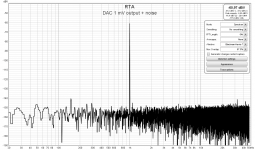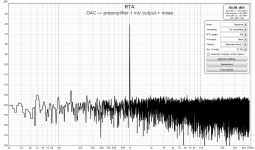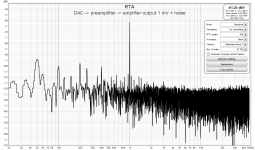In principle I agree with you, with a BIG point needing to be addressed: subjective perception is fine ... BUT holds true for that particular person ONLY.Not sure what you mean by that. For engineers looking for immediate technical answers, you may be right. For people who would like good sound as a final result, subjective data could be of interest.
Others will have THEIR OWN subjective perception.
Is anybody entitled to his own? Sure thing.
Can he argue others as in "but this is what I hear and stand by it" ?
Not really ... or at least , a useless argument.
First define "the sound of ferrite" 😉It is really hard to find posts on the web for people that like the sound of ferrite.
Many of the posts in the Head-Fi thread are self-fulling observations.
But a few may be about incorrectly installed ferrites.
But a few may be about incorrectly installed ferrites.
What theories are you referring to? (Please try not to misstate my positions, thank you 🙂 )
You are happy to accept, bring on board and expand on any idea of a possible reason for the perceived sound change. For you, it has no meaning if idea has no support in scientific knowledge (we should be open to new ideas, right?), or if best theoretical effect could be in the range of -100 to -200 dB (we don’t know the limits of our perception, no?).
To quote one fine opinion:
More on that is here: https://www.diyaudio.com/community/threads/funniest-snake-oil-theories.234829/post-7145253@Gnobuddy said:
The issue here is fairly simple: your personal bias is to err on the side of charity when it comes to subjective audio-related claims. If someone says they can hear the sound of two electrons rubbing together inside a PN junction, you might be willing to consider that claim.
Calling on example of scientific methods that start with observation, in this case by mere uncontrolled listening as an observation method of anecdotal quality, is not valid.
This forum is full of ‘evidence’ by people that hear profound change if wire insulation color is different, single resistor or capacitor is replaced with another type, 10 cm of internal wire is replaced with silver one and so on. Should we add intermittent packing flooding?
Humanity is looking inside atomic sub particles and to the end of universe, yet all science is defeated when audiophile mysteries should be explained or measured. We have no clue, so only listening remains as a valid method to reveal the truth. 🙄
You could once, for a change, make some measurements, instead of theorizing and ‘hearing’ or imagining things.
Are you saying you can't or won't give an example of a specific theory where I have taken an exact position that should properly be defined as 'fringe?'
Hello All
The utility of power conditioners and cords is well established, particularly for those living in cities or in industrial areas, but it is more difficult, at least for me, to make a case for that utility for those living in rural areas. I am wondering if there are any evaluations a DIYer can conduct that would indicate the need for such equipment?
Cheers,
ceulrich
To move this thread from opinions to real data, here are some measurements of noise floor from DAC to power amplifier output, with any effect that plain unshielded power cables and audio signal partially traveling through power earth wires between audio components has.
Location: rural area with surrounding industry like food processing, large warehouse freezers, several hundreds kW solar plant, metal processing industry with heavy welding machines. All that less than 1000 m from my house.
Noise was measured in 20 Hz – 48 kHz bandwidth using calibrated 60 dB LNA and Focusrite ADC + REW software. Measurement were taken as real time, without averaging, so any noise floor variations or additional noise peaks from EMI/RFI could be spotted. Connection from laptop to DAC was deliberately made with, out of specification, 7 m long USB cable (2 m standard one + 5 m extension of lowest imaginable quality). All power cables were ordinary 2 m long with no shielding.
As part of measurement, several clamp-on ferrite cores were added to power cords to se if there will be any change. There were absolutely none.
Equipment unweighted noise levels in bandwidth 22 Hz – 22 kHz:
- LNA – 0.066 uV (-143.6 dBV)
- DAC – 1.17 uV (-118.6 dBV) about -125 dBV to nominal 2 V output at RCA
- Preamplifier – 5.2 uV (-105.7 dBV) It has Schurter RF filter at mains input
- Power amplifier – 35 uV (-89.1 dBV) It has Schurter RF filter at mains input
RESULTS
- DAC output: it remains exactly the same with laptop powered from battery or AC, with 1 mV signal turned on or off. Observing noise floor, level and shape for several minutes period, does not bring a single hiccup in noise or signal level, apart from natural noise variation.
- Preamplifier output: now we have two power cords in effect. LNA is connected to the preamplifier output and level is again adjusted to 1 mV. There are no visible noise changes over longer time period, apart from elevated base level.
- Amplifier output: now three power cords are in effect. Again, no noise floor or signal level changes over time and no temporary peaks.
This is an example that reasonably well built equipment will be immune to mains noise and EMI and would not benefit from the ‘audiophile’ accessories.
Now, if audio equipment is built without any RF filters at power inputs and if audio ground is short circuit connected to power earth, there could be changes in noise and sound with Rapunzel type braided power cords and power conditioners. But, that is a wrong remedy.
Attachments
As part of measurement, several clamp-on ferrite cores were added to power cords to se if there will be any change. There were absolutely none.
Question: Did the equipment tested use power inlet modules with internal ferrite filters? If so, how did you test without ferrites?
If you did test without any ferrites, then we might go on to talk about the other problems with the measurements. Thanks 🙂
Last edited:
I along with many other people like the sound of solid core wire vs stranded wire. This includes power cords. Some people say it is because of strand jumping in stranded wire. Because of the proximity effect the current flow in a wire is on the side of the wire that is closest to the other conductor. The strands of wire twist so different strands are moving closer to the other conductor. I realize that most people reading this will not agree with solid sounding better, but there are real differences in the way current flows thru the wires. Skin effect and stranded wire is not used at very high frequencies. There is a Belden app note about this somewhere on the web.
Why would I do that? Test is performed on equipment as is under realistic conditions. AFAIK, DAC doesn’t have proper input RF filters. Preamplifier and amplifier have Schurter power entry modules with RF filter.Question: Did the equipment tested use power inlet modules with internal ferrite filters? If so, how did you test without ferrites?
However, it is important if there is noise on power earth wires, as this noise can affect audio signal ground through mandatory safety connection, avoiding any filters at power entry. If audio signal ground is connected to power earth through reasonably high resistance (NTC or resistor in parallel with diodes) noise is suppressed. Audio signal is always partially going through power earth wires between two devices. Ferrite cores or shielded/braided cords could benefit there if audio signal ground is short circuit connected to power earth and there is induced noise to speak of.
What was your experiment then intended to be? To vary the amount of ferrites on a power cord and then look for something in particular using FFTs? If so, looking for what exactly?
In other words, can you describe the intent of the experiment, possible sources of error, etc.? Tell us on what basis you chose the test signal settings and FFT parameters?
In other words, can you describe the intent of the experiment, possible sources of error, etc.? Tell us on what basis you chose the test signal settings and FFT parameters?
Not hype. I write now as I have a toroid in front of me suffering from it.I've been reading about DC offset on the mains voltage supply caused by the likes of electronic dimmers and computer power supplies.
It is claimed that less that 500 mV of DC can be sufficient to cause toroidal transformers to become saturated, which adversely affects sonic performance and may cause audible mechanical vibration.
View attachment 1107205
https://www.isol-8.co.uk/dc-on-the-mains
Is this a real phenomenon or just marketing hype?
Would you mind reading first post and the actual question? Power .,.,. cords …. EMI ….. RFI… effect.What was your experiment then intended to be? To vary the amount of ferrites on a power cord and then look for something in particular using FFTs? If so, looking for what exactly?
In other words, can you describe the intent of the experiment, possible sources of error, etc.? Tell us on what basis you chose the test signal settings and FFT parameters?
It was not about ferrites at all. They were checked along as I had them and were mentioned in this thread as noise suppression on cords.
To repeat, with reasonably well engineer equipment, there is no evil noise to take care off with snake oil products. No 'noise floor modulation' as well. 😉
1 mV signal was used because:
- any correlated noise effect couldn’t be spotted on large signal (none effect whatsoever was measured)
- 1 mV makes 1 V at LNA output, which is clipping limit of the. Focusrite ADC
Measurement confirmed that no fancy ‘audiophile’ power cords are needed to have equipment operate at lowest possible noise levels, without any ill effects on sound.
What an interesting discussion. I do appreciate the respect shown on each side. We can continue to learn in this manner so much more effectively.
An interesting thought would be> how will this discussion evolve in 20 years?
I just remember a physicist way back when who stated that we had learned all there is to know in the field of physics. I believe that was back in the 1840's or something.
An interesting thought would be> how will this discussion evolve in 20 years?
I just remember a physicist way back when who stated that we had learned all there is to know in the field of physics. I believe that was back in the 1840's or something.
Here's my concern. I have been ranted at and had exaggerations made about me because I believe in listening. Been told measurements are the only thing that matters, etc. Listening is never reliable, on and on it goes.
In response I would say I think some people put more trust in measurements than may be warranted. Sometimes measurements are not done well. Often they are accepted without question if they support the person's confirmation bias. And so on. I will try not to rant.
In summary, I don't think measurements are necessarily automatically 'facts" nor that listening is necessarily automatically 'imaginary.' That's too polarized for me. Hopefully we don't have to make this as polarized as politics has become.
In response I would say I think some people put more trust in measurements than may be warranted. Sometimes measurements are not done well. Often they are accepted without question if they support the person's confirmation bias. And so on. I will try not to rant.
In summary, I don't think measurements are necessarily automatically 'facts" nor that listening is necessarily automatically 'imaginary.' That's too polarized for me. Hopefully we don't have to make this as polarized as politics has become.
Regarding FFT settings to look for correlated noise, I would suggest that the guy in the following thread knew something about what he was doing: https://www.diyaudio.com/community/threads/phase-noise-in-ds-dacs.387862/post-7063038
When looking for uncorrelated noise I would like see averaged FFTs to significantly smooth random clutter in the noise floor. Otherwise every acquisition will look a little different purely due to random statistical variation. It may also be necessary to observe the overall noise floor with and without a high level test signal to look for noise that is correlated but more randomly distributed. In same cases correlated noise can be at a maximum at some intermediate test signal level and or at a particular frequency.
EDIT: An additional comment: There are reasons we are supposed to use the alternate hypothesis. It is one way to help overcome confirmation bias. If you go in thinking ferrites probably don't do anything, then you have to try hard to prove yourself wrong. A few quick FFTs may not be trying hard enough.
When looking for uncorrelated noise I would like see averaged FFTs to significantly smooth random clutter in the noise floor. Otherwise every acquisition will look a little different purely due to random statistical variation. It may also be necessary to observe the overall noise floor with and without a high level test signal to look for noise that is correlated but more randomly distributed. In same cases correlated noise can be at a maximum at some intermediate test signal level and or at a particular frequency.
EDIT: An additional comment: There are reasons we are supposed to use the alternate hypothesis. It is one way to help overcome confirmation bias. If you go in thinking ferrites probably don't do anything, then you have to try hard to prove yourself wrong. A few quick FFTs may not be trying hard enough.
Last edited:
Because of the proximity effect the current flow in a wire is on the side of the wire that is closest to the other conductor.
To further the discussion:
Yes, I read that in two adjacent conductors carrying alternating currents flowing in opposite directions, such as are found in a power cable, the current in each conductor is concentrated into a strip on the side facing the other conductor - the "proximity effect" you mention.
Since the current is concentrated into a smaller cross-sectional area of the conductor, the resistance of the conductor is increased, which will increase power loss.
I suggest that the same total effective change in resistance would apply regardless of whether the conductor was solid copper or stranded copper. In short, I don't regard proximity effect as an explanation for "solid sounding better".
And to mention "skin effect", whether the conductors be solid or stranded, is surely irrelevant to a power cable which operates at 50/60 Hz.
The proximity effect matters in stranded wire because it causes the current to jump strands as it is forced to stay on the side closest to the other conductor.
I do not know the slope of the filtering action of skin effect. It the charts say skin effect is happening within the audio band for a given wire size, could it not affect the 50th harmonic of the line frequency and the other harmonics? I and other can clearly hear the difference between stranded and solid power cable. If it did not matter why would Audioquest and Nordost bother with the harder to handle solid core wire?
I do not know the slope of the filtering action of skin effect. It the charts say skin effect is happening within the audio band for a given wire size, could it not affect the 50th harmonic of the line frequency and the other harmonics? I and other can clearly hear the difference between stranded and solid power cable. If it did not matter why would Audioquest and Nordost bother with the harder to handle solid core wire?
If it did not matter why would Audioquest and Nordost bother with the harder to handle solid core wire?
Because they are companies driven by profits?

P.S. At 60 Hz in copper, the skin depth is about 8.5 mm.
Last edited:
- Status
- Not open for further replies.
- Home
- Member Areas
- The Lounge
- Power Conditioners and Cords


